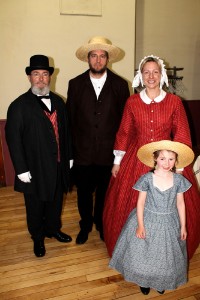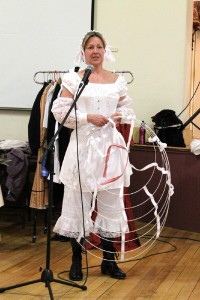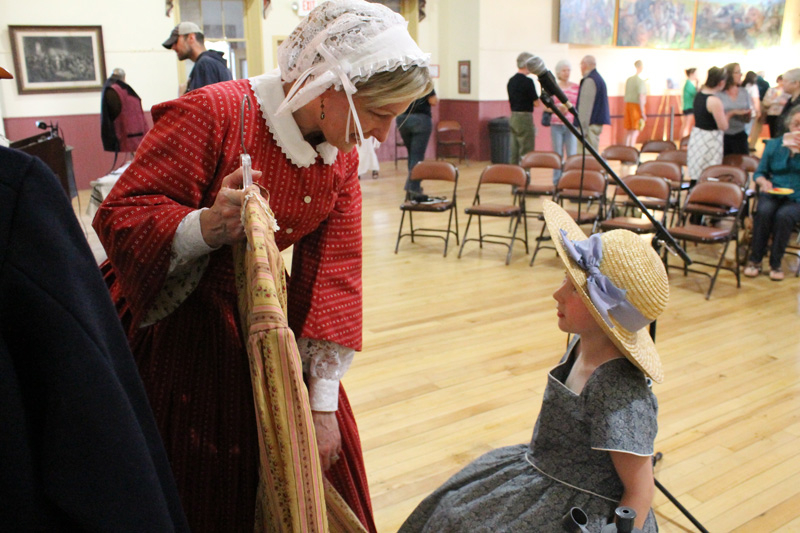1860’s clothing program part of anniversary effort
Corsets, hoop skirts, and bonnets, oh my!

From left: Jim Fouts, Bob Bushnell, Lynn Sawyer, and Mackenzie Smith bring St. Albans back in time, to the 1860s, with Civil War-era clothing as presented Wednesday night at the St Albans Historical Museum’s Bliss Auditorium, itself standing during the St. Albans Raid.
A special presentation in the St. Albans Historical Museum’s Bliss Room on Wednesday night brought area residents back in time, thanks to a program on Civil War-era dress presented by Vermont 18th Regiment volunteers for historic preservation.
The event, sponsored by the St. Albans Raid Commemorative Committee, aimed to help those planning to participate in period garb during the 150th anniversary of the St. Albans Raid. About 50 people attended.
The raid took place on Oct. 19, 1864. It will be commemorated on Sept. 18-21, 2014. Three banks were robbed, Confederate soldiers took more than $200,000 and fled to Canada where some of them were apprehended. The raid was the northernmost land action of the Civil War.
The Eighteenth Regiment’s Lynn Sawyer, of Cambridge, dressed as a woman of the 1860’s, peeled off yards of cloth to truly reveal how a woman dressed 150 years ago. Her models also included a six-year-old girl and two men.
That time in history was not unlike today, she said, in that women had more clothing options than men. As with any era there are no absolutes, but Sawyer noted there were aspects of the fashion of those times that can be easily replicated.
The St. Albans community, as any during Civil War times, contained many different social classes and all dressed appropriately to their status. An everyday working class person would not wear expensive silk, for example.
While the poor, the middle class, and well to do did not all look exactly alike, the rule was conformity, Sawyer noted. Going outside of the norm could mean social suicide.
In addition to status-specific garb, people wore age-appropriate clothing. Younger unmarried women tended to wear light or pastel colors, hoping still to attract a man to provide for them. Married women dressed to the nines at formal events but otherwise kept things simple.
“Once you were married, you’d go somber,” Sawyer said.
Women either wore nothing on their heads, a cap to cover their hair, or an ornate bonnet. Sun protection was a parasol.
Pierced earrings, matching bracelets, broaches, watch chains, and cameos were popular accessories at the time and thanks to their cumbersome dresses, many women had room to hide a purse right inside their dresses.
Ladies in the 1860s faced much criticism if they did not abiding by rules: skirt lengths and the amount of skin showing could prove controversial. Some things never change.
“Showing an ankle could be scandalous,” Sawyer said, though she noted that at a ball, shoulders and décolletage would likely be on display. In fact, she added, some 1860’s ball gowns today would seem too revealing.
Dresses could be made of the cheaper cotton or expensive silk. Most featured gathered bodices, loose sleeves, and seemingly unmanageable hoop skirts and layers of petticoats. An hourglass figure was considered the ideal and clothing was tailored to accentuate that ideal. The average height then was 5’3”.
That said, Sawyer explained, “Not everybody had a 19-inch waist.” To whittle the middle, most women utilized corsets. Some starting at young ages would literally grow into a corseted hourglass shape, despite health warnings against it.

Lynn Sawyer, stripped down to just her undergarments and corset, shows the audience how to put on a hoop skirt. The skirts helped achieve the era’s desired hourglass figure, as did dropped shoulders and oversize sleeves.
Sawyer showed what era-appropriate undergarments looked like, explained how split drawers allowed for bathroom trips while in billowy gowns, and put on a corset.
“Now I’m totally inappropriate for the Victorian era, unless I was a woman of the town,” she joked, standing before the crowd in white undergarments, though even then minimal skin managed to peek out.
Sawyer said the term “loose woman” came from this era, loose meaning corset-less. The term “pulling yourself together” stems from lacing the garment and being an “upright person” related to the whalebone stays that held women rigidly in that position.
A corseted woman was viewed as a better woman in every respect, Sawyer explained. Wearing a corset was to be moral and they were advertised as helping to improve one’s character and performance as a wife, mother and all-around homemaker. For the 2014 Civil War costume ball she said women, rather than corseting, could wear Spanx undergarments. She said, too, that wedding dress hoops, sold on eBay for $20, could replace the heavier structure of the hoops of Civil War times, but they should never allow petticoats to show.
Her socks were held in place with a garter, as elastic was not yet a popular concept.
Girls’ clothing was very similar to women’s, and model Mackenzie Smith, 6, daughter of Tim and Denise Smith of St. Albans, looked like somewhat like the popular children’s character, Madeline, as she modeled a straw hat, a blue, billowy dress, a day coat with pagoda sleeves, and rounded-toe black boots.

Mackenzie Smith, 6, models Civil War-era clothes as Lynn Sawyer from historic preservation group the Vermont 18th Regiment describes fashion trends popular at that time. In September 2014 folks will don period-appropriate clothing to participate in commemoration events for the 150th anniversary of the St. Albans Raid.
Children had short hair regardless of gender, Sawyer said, but girls parted theirs down the middle and boys at the side.
Girls’ corsets with shoulder straps were worn, though most did not begin corseting until their teen years. Mothers decided when their daughters transitioned from a more youthful look to that of a woman, Sawyer said.
Men’s clothing, as is the case today, was not as intricate as women’s. Men wore simple black pants, black boots, typically, and white shirts for most occasions, buttoned all the way up to the neck.
The mass production of military uniforms during the war had already brought men’s clothing to a different marketing level than women’s wear, however. Men’s ready-to-wear shirts, coats and pants were available in standard sizes. Women’s clothing, however, was tailored and sewn to an individual until a decade or so after the war.
“Braces” – suspenders – held up men’s typically wool pants that came to the navel.
“I don’t know how guys survived in wool all summer, but they did,” Sawyer said.
Bob Bushnell, of Fairfax, modeled a simple worker’s outfit Wednesday night while Jim Fouts, of St. Albans, portrayed a well-off man in a waistcoat, red and white striped vest, bow tie, and white gloves.
During the Civil War era, it seems that the coat made the man. Sack coats were worn by younger men and boys and were mass marketed. Frock coats were longer and more dressed up and had different qualities depending on social status.
Formal wear was high class and included swallow-tailed suits and black vests or, for extra-special events, white shirts, vests, ties, and gloves.
Sawyer said a shirt was considered an undergarment, the reason that coats are visible on nearly every vintage portrait.
Men’s facial hair was a “free for all” Sawyer explained, including mustaches, beards, clean-shaven faces, sideburns, muttonchops, or any combination thereof.
Hats varied from wide-brimmed straw to shield the sun to bowlers and top hats. Jewelry included a pocket watch, rings, and tiny eyeglasses.
Donning sunglasses while in period clothing during raid anniversary events is probably not a good idea. Sawyer explained tinted glass was reserved for sharpshooters or those with measles or venereal disease.
Next fall it might be best to squint.
“Unless you want to be confused for someone with syphilis, you might want to forgo the sunglasses,” Sawyer noted.
By JESSIE FORAND Messenger Staff Writer








